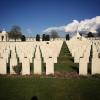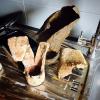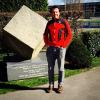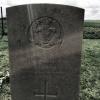- News
- Reviews
- Bikes
- Accessories
- Accessories - misc
- Computer mounts
- Bags
- Bar ends
- Bike bags & cases
- Bottle cages
- Bottles
- Cameras
- Car racks
- Child seats
- Computers
- Glasses
- GPS units
- Helmets
- Lights - front
- Lights - rear
- Lights - sets
- Locks
- Mirrors
- Mudguards
- Racks
- Pumps & CO2 inflators
- Puncture kits
- Reflectives
- Smart watches
- Stands and racks
- Trailers
- Clothing
- Components
- Bar tape & grips
- Bottom brackets
- Brake & gear cables
- Brake & STI levers
- Brake pads & spares
- Brakes
- Cassettes & freewheels
- Chains
- Chainsets & chainrings
- Derailleurs - front
- Derailleurs - rear
- Forks
- Gear levers & shifters
- Groupsets
- Handlebars & extensions
- Headsets
- Hubs
- Inner tubes
- Pedals
- Quick releases & skewers
- Saddles
- Seatposts
- Stems
- Wheels
- Tyres
- Health, fitness and nutrition
- Tools and workshop
- Miscellaneous
- Tubeless valves
- Buyers Guides
- Features
- Forum
- Recommends
- Podcast
OPINION
Unfair Stood the Wind for France: Dominic Cox tours the battlefields - but weather scuppers pavé plans
Dominic Cox headed across the Channel last week to visit the battlefields of Belgium and Northern France – and to ride his bike over the famous pavé of Paris-Roubaix. But the weather thwarted the road.cc user from Northamptonshire’s plans. Here’s his story …
Here’s a confession. I am a MAMIL: my running days ended through recurrent hamstring and calf tears. I was pushing 50 and weighed more than 100kg from inactivity and gluttony.
I’d always mountain biked from living near the Cairngorms, but was uncomfortable on the road, hating the traffic. Living in Northamptonshire now, mountain biking is limited, and boredom doesn’t motivate. So I dug out the old road bike and headed back on the road. I started to love it. My mountain bike started to grow cobwebs.
Of course I wanted a new bike: a shiny new light carbon fibre beauty. I denied myself that pleasure until my first 10kg had gone, picking up a Trek Modane in the sales. Cancellera’s weapon built for the cobbled classics, the bike with the special decoupled seat post to ease the vibration of the pavé.
Paris-Roubaix, nicknamed the “Hell of the North” after they tried to find a serviceable route through apocalyptic battlefields, post-WWI, 30+ km of cobbled secteurs. Why not give it a go? How hard could it be?
So with a pre- Easter boys’ tour with my 12 year old son and his godfather to see the historical battlefields of France and Belgium, I’d take my bike and do the top half of Paris-Roubaix route including the Carrefour de l’Arbre and culminating in the velodrome at Roubaix.
Preparation: I upgraded my wheels to something that could hack the rougher roads, with 27mm road tyres set to only 75-80 psi, and gelled my handlebars covered by the best tape. I increased my riding steadily to 150km a week, practicing explosive 1-2km high intensity intervals to mimic the power outputs needed for the pavé segments.
Two weeks beforehand I headed off to Tenerife with Polkadot cycling holidays for 6 days with 9000m climbing and over 400km of supported training and enthusiastic coaching, a great holiday taking in Europe’s longest continuous ascent. I was ready!
I had the bike, I‘d lost 20kg, I’d put the miles in. I’d run through a virtual Paris-Roubaix on Google Street View. But I wasn’t quite sure of my skills on the pavé.
First, the history.
Day 1: Dover Castle
In the chalky tunnels, originally 18th Century, we learn about Operation Dynamo (the Dunkirk miracle), co-ordinated here. It gets windy, the ferry is delayed, so we miss seeing Dunkirk beach at low tide. We can just make out the tops of sunken ships now mostly hidden by the waves. We struggle to stand up because of the wind on the beach. We head to Brussels to stay with a friend.
Day 2: Waterloo
2015 is the 200th anniversary of Waterloo, so we head to the battlefield. It’s very windy, stripping you of all body heat in seconds, and horizontal rain blasts us. In these days Fabian Cancellara crashes at E3 Haralbeke, fracturing his spine; Geraint Thomas is blown off his bike at Gent Wevelgem, only 39 of 200 riders finishing the race. Shelving plans for a quick spin, we end today at the free Royal Military Museum in Brussels. We eat mussels, frites and mayonnaise somewhere behind the Grand Place. Outside, waiters chase tables blown away by the wind.
Day 3: St Symphorien Military Cemetery and Lochnagar Crater
It’s really windy at St Symphorien Military Cemetery, with recently uprooted trees. The Allies are scattered in groups together with the German graves, the farmer who donated the land for this beautiful small cemetery near Mons insisting the dead from both sides be buried together.
But there’s a contrast. The Allied headstones have symmetry and equality, rank conferring no authority in death, all equal in their sacrifice; the German graves are more hierarchical.
.jpg)
Here, the first and last British soldiers killed by gunfire in WWI lie opposite each other. Boy cyclist George Parr was killed on reconnaissance on 21 August 1914, perhaps by confused allies. George Ellison died of wounds caused by the last volley, as the guns fell silent on 11 November 1918.
We continue to Lochnagar Crater, where a massive British mine was exploded under German trenches. On the Somme’s vast, bleak landscape of rolling hills and fields of mud, the wind has nowhere to stop.
Here and there, small, dignified, well-tended cemeteries, the roadsides immersed with the memory of the fallen. The jokes stop in the car for a long while.
.jpg)
Then, it’s off road through a small village to a tiny, isolated and immaculate cemetery where my Great Uncle Edwin Green is buried.
Like so many, he persisted in joining up when his local regiment was full. He won the Distinguished Conduct Medal aged 20, and was RSM at 21.
His story is not unique in a world we can hardly imagine. In the surrounding field we find a few scraps of disappointing shrapnel. My son would like more.
Shivering from the wind, we return to the car,finding in the mud near our wheels two hardly deformed shrapnel shells. They must have buried themselves in the mud before exploding; the heads aren’t shattered, just bent and deformed. We have one happy boy!
.jpg)
We overnight in Fampoux, a village in the frontline of the battle of Arras with more cemeteries than shops. No houses predate 1920. Dinner in Arras overlooking the wonderful, reconstructed Main Square where only four buildings remained in 1918.
Day 4: The day of the (non-)ride
The wind gusts to over 80kmh. It’s raining. I think of Rule 5, my inexperience on cobbles, and the need to keep the power up to cross them. Even with the wind behind me it will be dodgy. I check. The wind is full in my face for most of the route.
The “pros” have been dropping like flies on a day less windy and less wet. They get paid for it. I’m getting on in years and at best a middle of the bunch, club rider. I’d never go out in this wind at home. I’d be in the garage on the turbo: Sufferfesting.
I’ve bigged this up to myself and friends. There’s Rule 5. Equally there is common sense, understanding one’s own limitations. I bin it. I don’t get on my bike. I’ve prepared and trained for this one ride, I haven’t been out for four days. I’m frustrated.
As Plan B we go underground to the Arras Caves – out of the wind! The old stone quarries housed 25,000 soldiers. A really good tour in the dark lets you feel what it was like, and you can see sculpting and pictures left by soldiers from 100 years ago.
Then onto the Canadian cemetery at Vimy Ridge. The monument is beautiful and stunning. The old trench lines have been kept intact, the surrounding terrain pockmarked by huge shell craters. Signs warn of unexploded ordnance. They use sheep to keep the grass down – they’re cheaper than exploding lawn mowers. I have my balaclava and five layers on. The wind cuts through it like I was naked.
I’m not riding but I want to go to Roubaix, to see what it’s like for when I return one day. Across from the velodrome is the Roubaix CC clubhouse. No problem getting a drink or buying club jerseys.
.jpg)
In the bar, a scattering of granite-hardened, old, French, cyclists. Tough looking faces but friendly enough. There was a bit going on with the race a fortnight away. I nervously ask whether it’s okay to cycle the velodrome? I’m told, “It’s okay, but it closes soon.” The man switches to French: “Le vent est fou.” It has been for some days now.
I rush to the car, get the bike together and fire up the Garmin,and get changed as discreetly and quickly as possible. At the worst possible moment, a bunch of school children pass by.
It’s still really windy but I’m clipped in and off. I get a stern look from the security guard, whom I expect to arrest or remove me, but the look is enough to make me want to get on with it and that’s all.
The track is 500m of banked concrete with bumpy ridges between the concrete segments. A massive crowd of three watch the slowest laps of the velodrome ever. I’ve never been in a velodrome let alone cycle one with the wind gusting wickedly.
I avoid any suggestion of taking my speed from the straight to bank high on the corner. The wind is too gusty over the lip.
Inwardly I do not want the embarrassment of sneaking into the Roubaix velodrome, falling off and having to be rescued by the grumpy security guard. After four laps I retire intact. Naturally I post my first, second and third best times on Strava having done a few laps. I’m 53rd out of 240 people in my age group; I bet no one else had the same wind gusts.
My son fiddles with my Garmin on the way out. It’s left on and records us driving away. Later that night that I edit out the extra bit. Briefly I kick Niki Terpstra’s butt on Strava by a mere 30 kph. I do the decent thing, edit the ride and restore Niki to KOM.
We go on to Tyne Cot Cemetery, where 12,000 are buried, 70 per cent unknown with a further 34,870 with no known grave commemorated on the wall, and then stay in Ypres, 200m from the Menin Gate.
.jpg)
There, 54,896 men whose bodies were never found, remembered each evening in a dignified, simple ceremony by the Belgians. Some people are near tears but the massed ranks of visiting schoolchildren keep the dignity of occasion. We find “the Godfather’s” Great Uncle’s plaque. ”T. Crichton of the Black Watch”. Unlike my great uncle, his body was never found.
We also find Edgar Mobbs’s memorial. A leader of men, captain of Northampton Saints Rugby Club and of England. Too old to be given a commission, he rose through the ranks to Lt Col. He died assaulting a machine-gun post, his body never found. Few senior officers’ names are on the Menin Gate; I suspect few of those who are died leading an assault.
His name endures with a Southern East Midlands kids’ rugby tournament my son’s team plays in. He also has the longest standing club rugby fixture named after him, held on alternate years between the Army and Northampton Saints or Bedford on alternate years. It now raises money for Help for Heroes.
Day 5: Riding the Ypres battlefront
The wind has lessened. It is only blowing 25 to 30mph. I layer up and set off for a 50km route around the Ypres battlefront, passing Polygon Ridge and Passchendaele, losing count of the cemeteries.
There’s a demoralising headwind returning to Ypres, like cycling up a 10 per cent gradient. I stay tucked and grind it. I think of dour, tough Belgium cyclists and understand where they came from. It’s great to be back on the bike. I cycle through the Menin Gate and grab coffee.
We head home. We were going to go past Agincourt to complete the wheel of history, but the site is uncelebrated by the French, so we skip it and stop at the V2 rocket site on the way back to Calais, our third trip underground.
So I failed. I planned, trained and prepared myself and the bike to ride a good part of the Paris Roubaix route. I did not even set off. Even with more preparation I wouldn’t have set off in those conditions. I’ve walked and climbed Scottish Hills on good days and bad. I learnt getting to the top was never the best bit. That was the journey itself: the planning, company, sweat, etc.
I’m 50. I’ve fallen in love with road cycling. I’m a MAMIL and proud of it. I’m proud of losing 20kg, of being healthier, and I enjoy the ride. I’ve gained so much from cycling and I’m grateful to the sport.
I’ll return to Paris-Roubaix; Col de la Madone, I’ll see you in a couple of weeks.
Simon joined road.cc as news editor in 2009 and is now the site’s community editor, acting as a link between the team producing the content and our readers. A law and languages graduate, published translator and former retail analyst, he has reported on issues as diverse as cycling-related court cases, anti-doping investigations, the latest developments in the bike industry and the sport’s biggest races. Now back in London full-time after 15 years living in Oxford and Cambridge, he loves cycling along the Thames but misses having his former riding buddy, Elodie the miniature schnauzer, in the basket in front of him.
More Opinion
Latest Comments
- cmedred 20 sec ago
101 hours? Peanuts. Drivers in Chicago, America's "Windy City,'' racked up 155 hours in 2022: https://i-290blueline.com/chicago-commuters-lost-more...
- cmedred 8 min 59 sec ago
Unbelievable. But the judge does deserve some sort of award for managing to make himself a giant gasbag of a hypocrite: You "would rather someone...
- Sriracha 3 hours 12 min ago
Taunton slider?
- Tomsmith90 3 hours 42 min ago
Ah ok that's great appreciate the condolences and thank you for your time
- Circles 4 hours 9 min ago
Funny how so many drivers bring up the point that they pay for insurance, implying that cyclists should too. One has always been a legal...
- Rendel Harris 5 hours 59 min ago
Othering of those in non-conformist outgroups. Lists of persons regarded as "villains" to be hated by society. Language comparing targets to vermin...
- lesterama 8 hours 3 min ago
There's a big difference between 54/11 and 56/10. Just sayin'.
- Dr Watson 8 hours 17 min ago
I’ll be playing all year again if it’s on. Pleeease.
- chrisonabike 11 hours 58 min ago
It would have to be the police's cars... although stealing bikes from a police station does seem to fall in to the "low hanging fruit" bracket for...
- Hirsute 13 hours 12 min ago
13 vehicles crashed through my wall. https://www.bbc.co.uk/news/articles/clyvegw54e5o Time for some proper bollards!





Add new comment
4 comments
Nice write up, shame the weather messed with your plans, it's great countryside for riding.
The comments on the Snr Officers made by gmac101 above are accurate, if you wish to expolre further I recommend 'Mud Blood and Poppycock' by Gordon Corrigan as a good read.
Interesting and well written travelogue. Thanks for posting it.
Don't be too hard on the senior officers, 78 British Generals died in action during ww1 and many more were wounded. There were orders preventing them from getting too close to the action as most were very experienced soldiers who the army could not afford to lose. There were an amount of incompetent and inadequate officers but most were pretty good.
Thanks for your fact based thoughts. There weren't a huge amounts of senior officers on the gate which reflects your point. They may have died in ways in which their bodies could be buried. good point and thanks